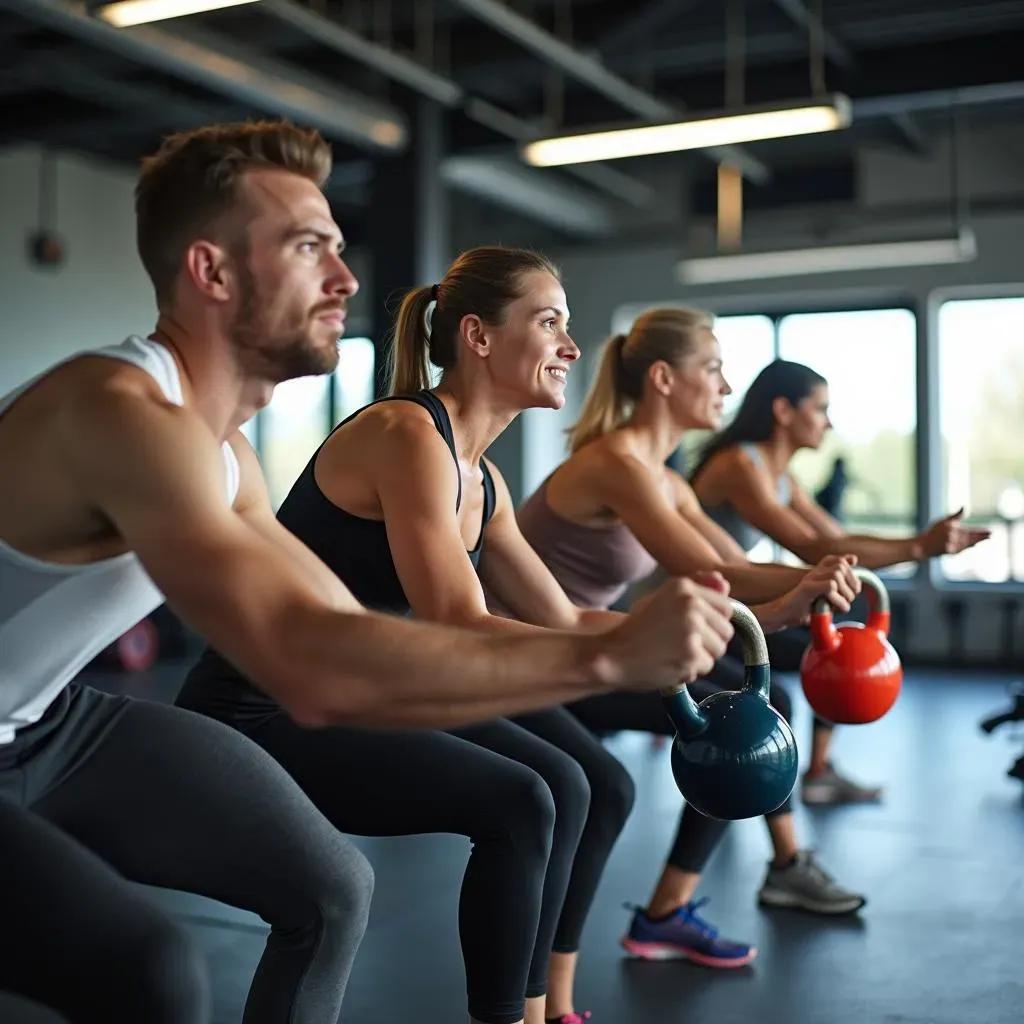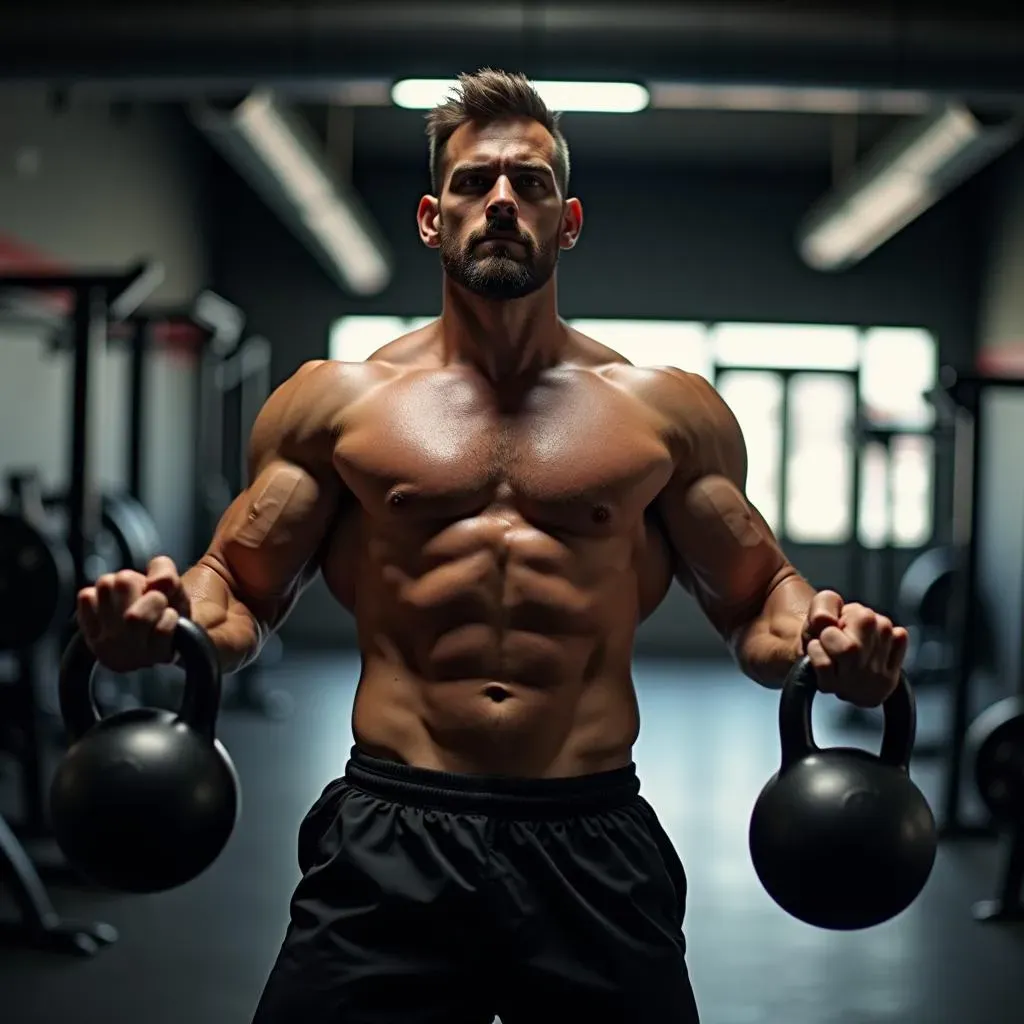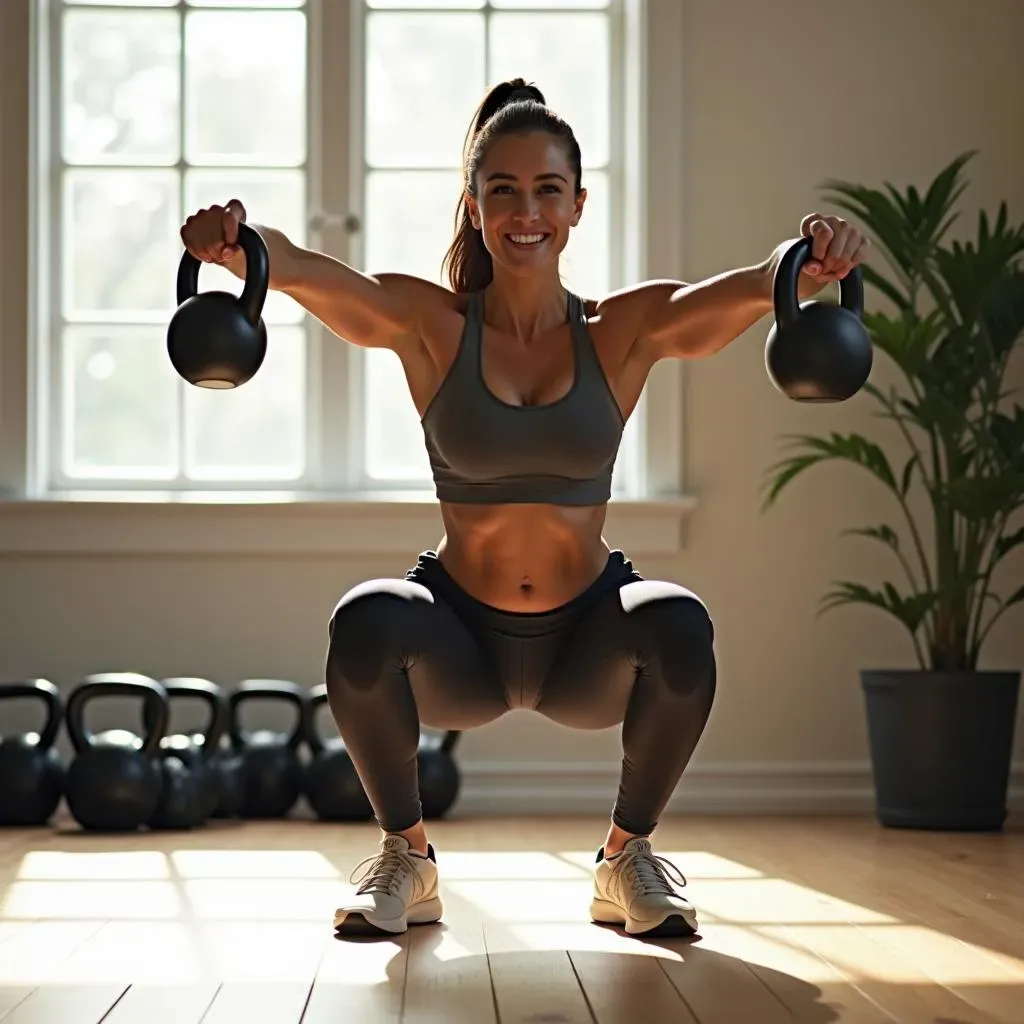Table of Contents
Ready to swing into shape? Kettlebells might look intimidating, but they're an awesome tool for building strength, burning calories, and improving your overall fitness. If you're just starting out, knowing where to begin can be overwhelming. That's where this guide comes in. We're breaking down the 5 kettlebell exercises for beginners that will give you a solid foundation. These aren't random moves; they're the building blocks for more advanced kettlebell training.
Master the Basics: 5 Essential Kettlebell Exercises for Beginners

Master the Basics: 5 Essential Kettlebell Exercises for Beginners
Why Kettlebells? Your Gateway to Full-Body Fitness
So, you're curious about kettlebells? Awesome! They're not just trendy gym toys; they're seriously effective tools for building strength, improving your cardio, and boosting your overall athleticism. Unlike traditional dumbbells, kettlebells have an offset center of gravity, which forces your body to work harder to stabilize and control the weight. This translates to more muscle activation, a higher calorie burn, and improved functional fitness – meaning you'll be stronger and more capable in your everyday life.
But where do you start? With so many exercises out there, it's easy to feel lost. That's why we've curated these 5 kettlebell exercises for beginners. These moves are foundational, meaning they'll teach you the proper movement patterns and build the necessary strength and stability to progress to more advanced exercises. Master these, and you'll be well on your way to reaping all the amazing benefits kettlebells have to offer.
The Fab Five: Your Kettlebell Starting Lineup
Alright, let's dive into the exercises themselves. Don't worry about trying to lift super heavy right away. Focus on mastering the form first. It's better to start with a lighter weight and gradually increase it as you get stronger and more comfortable. Remember, quality over quantity!
Here's a quick overview of the 5 kettlebell exercises for beginners we'll be covering:
- Slingshot: A gentle warm-up that improves shoulder mobility.
- Halo: Another great warm-up that targets the shoulders and upper back.
- Good Morning: Teaches the hip hinge, essential for many kettlebell exercises.
- Single Arm Deadlift: Builds strength in the posterior chain (glutes, hamstrings, back).
- Goblet Squat: Improves squatting form and builds leg strength.
Kettlebell Slingshot and Halo: Warming Up the Right Way

Kettlebell Slingshot and Halo: Warming Up the Right Way
Why Warm-Up? Prime Your Body for Action
Before you start swinging and squatting, it's crucial to warm up your muscles and joints. Think of it like prepping your car engine before a long drive. A proper warm-up increases blood flow, improves mobility, and reduces the risk of injury. The kettlebell slingshot and halo are two fantastic exercises for getting your shoulders and upper back ready for the workout ahead. They're low-impact, gentle, and effective at increasing range of motion.
These movements might seem simple, but don't underestimate their power. They help to lubricate the shoulder joints, activate the rotator cuff muscles, and improve overall shoulder stability. This is especially important if you spend a lot of time sitting at a desk or have a history of shoulder issues. Plus, they're a great way to get your mind focused and prepare yourself mentally for the workout.
Slingshot and Halo: Step-by-Step Guides
Alright, let's break down the proper form for each exercise. Remember, it's all about control and precision. Start with a light kettlebell (or even just use your hand to mimic the movement) until you feel comfortable with the technique.
Kettlebell Slingshot
- Stand with your feet shoulder-width apart, holding the kettlebell by the handle in front of your body.
- Gently swing the kettlebell around your body, passing it from one hand to the other in a circular motion.
- Keep your core engaged and your back straight.
- Continue for 30-60 seconds in each direction.
Kettlebell Halo
- Stand with your feet shoulder-width apart, holding the kettlebell upside down by the horns (the rounded part).
- Slowly circle the kettlebell around your head, keeping it close to your body.
- Maintain a stable core and avoid shrugging your shoulders.
- Continue for 30-60 seconds in each direction.
Pro Tip: Imagine you're drawing a circle around your head with the kettlebell during the halo. This will help you maintain a smooth and controlled movement.
Building Strength: Good Mornings, Single Arm Deadlifts, and Goblet Squats

Building Strength: Good Mornings, Single Arm Deadlifts, and Goblet Squats
The Power Trio: Why These Exercises?
Now that we've warmed up, it's time to get serious about building strength. These three exercises – Good Mornings, Single Arm Deadlifts, and Goblet Squats – are fantastic for developing a strong foundation in kettlebell training. They target key muscle groups, improve your posture, and teach you essential movement patterns.
What's so special about these three? Well, the Good Morning teaches you the hip hinge, which is crucial for swings and other dynamic kettlebell movements. The Single Arm Deadlift builds strength in your posterior chain (glutes, hamstrings, back) and improves your balance. And the Goblet Squat helps you perfect your squat form while engaging your core. Together, they form a powerhouse of strength and stability.
Good Morning: Mastering the Hip Hinge
The Good Morning might sound like a friendly greeting, but it's actually a challenging exercise that targets your hamstrings, glutes, and lower back. The key is to maintain a straight back and hinge at your hips, as if you're bowing to someone. This movement teaches you how to properly load your posterior chain, which is essential for preventing injuries and maximizing your power in other exercises.
Here's how to do it:
- Stand with your feet shoulder-width apart, holding the kettlebell in front of your chest with both hands (like you're hugging it).
- Engage your core and keep your back straight.
- Hinge at your hips, pushing your glutes back as you lower your torso towards the ground.
- Keep a slight bend in your knees and maintain a straight line from your head to your tailbone.
- Lower as far as you comfortably can without rounding your back.
- Squeeze your glutes and hamstrings to return to the starting position.
Common Mistakes: Rounding the back, bending the knees too much, using too much weight.
Single Arm Deadlift and Goblet Squats: Building a Solid Base
The Single Arm Deadlift is a variation of the traditional deadlift that challenges your balance and core stability. By holding the kettlebell in one hand, you force your body to work harder to prevent rotation and maintain proper alignment. This exercise is great for building strength in your glutes, hamstrings, back, and core.
The Goblet Squat is a fantastic exercise for improving your squat form and building leg strength. By holding the kettlebell in front of your chest, you encourage a more upright torso and deeper squat. This exercise is also great for engaging your core and improving your overall stability.
Exercise | Muscles Worked | Benefits |
|---|---|---|
Single Arm Deadlift | Glutes, Hamstrings, Back, Core | Builds strength, improves balance, challenges core stability |
Goblet Squat | Quads, Glutes, Hamstrings, Core | Improves squat form, builds leg strength, engages core |
Beginner Kettlebell Workouts: 4 Simple Routines to Get You Moving

Beginner Kettlebell Workouts: 4 Simple Routines to Get You Moving
you've learned the basic moves. Now it's time to put them together into some simple but effective workouts! These beginner kettlebell workouts are designed to be short, sweet, and scalable. That means you can adjust the intensity and duration to fit your current fitness level. Remember, consistency is key. Aim to do these workouts 2-3 times per week, with rest days in between. Don't rush the process; focus on mastering the form and gradually increasing the weight or repetitions as you get stronger.
These workouts are structured as 4-minute blocks. You'll perform each exercise for a set amount of time, followed by a short rest. The goal is to complete as many rounds as possible (AMRAP) within that 4-minute window. After each 4-minute block, take a longer rest (around 1-2 minutes) before moving on to the next workout. Start with one circuit of all four workouts, and gradually work your way up to three circuits as you get fitter. You can then increase the weight!
Workout 1: The Foundation Builder
This workout focuses on building a solid base of strength and stability. It includes the Goblet Squat and Single Arm Deadlift, which are excellent for engaging your core and strengthening your lower body.
- Goblet Squat: 30 seconds
- Rest: 15 seconds
- Single Arm Deadlift (Right): 30 seconds
- Rest: 15 seconds
- Single Arm Deadlift (Left): 30 seconds
- Rest: 15 seconds
Workout 2: Hip Hinge Power
This routine emphasizes the hip hinge movement, crucial for kettlebell swings and other dynamic exercises. The Good Morning will help you strengthen your hamstrings and glutes, while improving your posture.
- Good Morning: 45 seconds
- Rest: 15 seconds
Workout 3: Shoulder Mobility
This workout is all about improving shoulder mobility and stability. The Kettlebell Slingshot and Halo are gentle exercises that will help you warm up your shoulders and prevent injuries.
- Kettlebell Slingshot (Clockwise): 30 seconds
- Rest: 15 seconds
- Kettlebell Slingshot (Counter-Clockwise): 30 seconds
- Rest: 15 seconds
- Kettlebell Halo (Clockwise): 30 seconds
- Rest: 15 seconds
- Kettlebell Halo (Counter-Clockwise): 30 seconds
- Rest: 15 seconds
Workout 4: The Finisher
This workout combines elements of strength and cardio, providing a great full-body challenge. The Goblet Squat and Good Morning will work your lower body and core, while also elevating your heart rate.
- Goblet Squat: 30 seconds
- Rest: 15 seconds
- Good Morning: 30 seconds
- Rest: 15 seconds
Workout | Focus | Exercises |
|---|---|---|
1 | Lower Body Strength | Goblet Squat, Single Arm Deadlift |
2 | Hip Hinge | Good Morning |
3 | Shoulder Mobility | Slingshot, Halo |
4 | Full Body | Goblet Squat, Good Morning |
Progressing Safely: Weight Selection and Workout Structure for Kettlebell Newbies

Progressing Safely: Weight Selection and Workout Structure for Kettlebell Newbies
Choosing the Right Weight: Start Light, Go Slow
Alright, let's talk about weight selection. This is crucial for preventing injuries and ensuring that you're getting the most out of your workouts. As a general rule, it's always better to start too light than too heavy. You can always increase the weight later, but you can't undo an injury. For women, a good starting weight is typically between 8kg (18lbs) and 12kg (26lbs). For men, a good starting weight is typically between 12kg (26lbs) and 16kg (35lbs). However, these are just guidelines. The best weight for you will depend on your individual strength level and experience.
How do you know if you're using the right weight? You should be able to perform all of the exercises with good form and control. If you're struggling to maintain proper form, or if you're feeling any pain, then the weight is too heavy. Don't be afraid to drop down to a lighter weight until you feel more comfortable. Remember, it's not a race! Focus on mastering the movements first, and the strength will come.
Workout Structure: Building a Solid Foundation
Now that you've chosen your weight, let's talk about workout structure. The key is to start slowly and gradually increase the intensity and duration of your workouts. As we mentioned earlier, these beginner kettlebell workouts are structured as 4-minute blocks. Start with one circuit of all four workouts, and gradually work your way up to three circuits as you get fitter. You can then increase the weight!
Here's a sample workout schedule for a beginner:
- Monday: Workout 1 (1-3 circuits)
- Tuesday: Rest
- Wednesday: Workout 2 (1-3 circuits)
- Thursday: Rest
- Friday: Workout 3 (1-3 circuits)
- Saturday: Rest or light activity
- Sunday: Workout 4 (1-3 circuits)
Remember to listen to your body and take rest days when you need them. It's better to take a day off than to push yourself too hard and risk injury. And don't forget to warm up before each workout and cool down afterward. This will help to improve your mobility, reduce muscle soreness, and prevent injuries.
Workout | Circuits | Reps | Rest |
|---|---|---|---|
Workout 1 | 1-3 | As many as possible in 4 minutes | 1-2 minutes between circuits |
Workout 2 | 1-3 | As many as possible in 4 minutes | 1-2 minutes between circuits |
Building a Solid Foundation with 5 Kettlebell Exercises for Beginners
Mastering these 5 kettlebell exercises for beginners is your first step towards unlocking a world of strength and fitness. Remember, it's not about lifting the heaviest weight right away; it's about learning proper form and building a solid foundation. Take your time, listen to your body, and gradually increase the intensity as you get stronger. With consistent practice and dedication, you'll be amazed at what you can achieve. So keep swinging, keep squatting, and keep building that kettlebell strength!